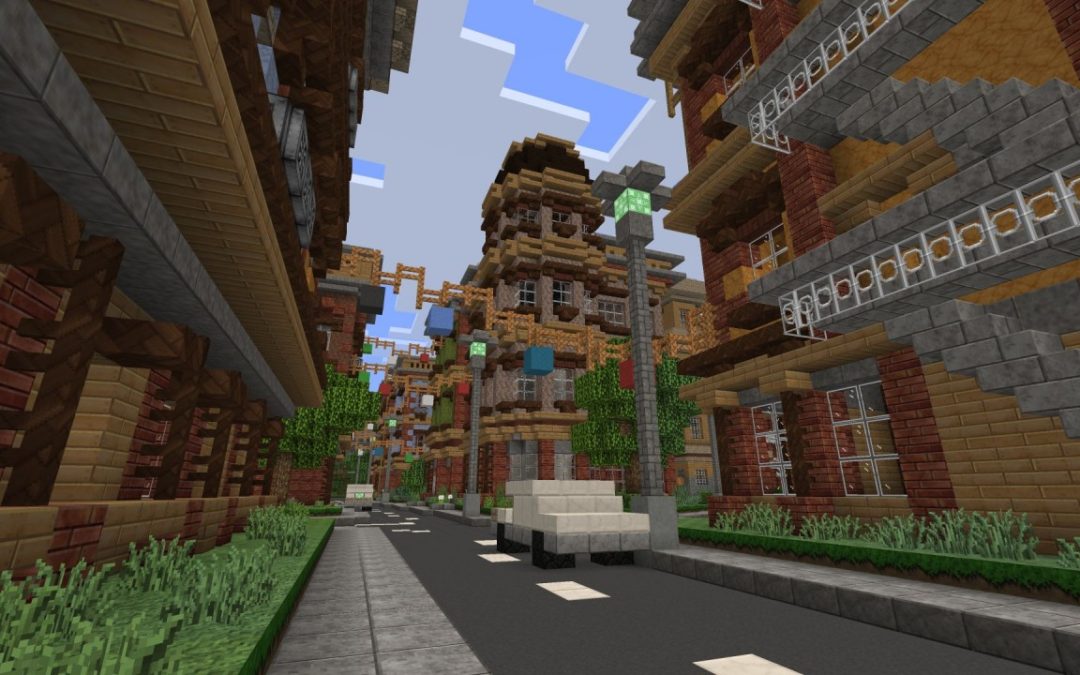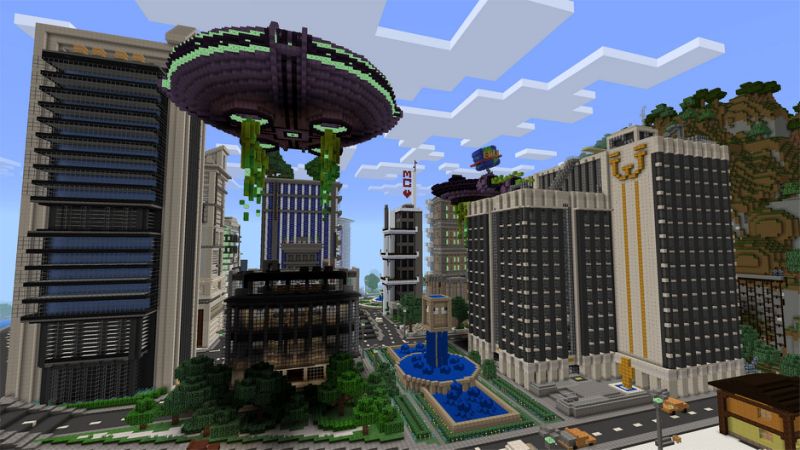
by Stone Marshall | Jun 22, 2016 | Minecraft News |
LOS ANGELES — In Minecraft, you can build just about anything you want, unless those things happen to be different enemies, behaviors or scenarios. Modders cracked the Minecraft software and started adding onto it long ago, but doing so it not easy for the average user, which is why Microsoft has begun to add simple, no-nonsense modification (“modding”) options that let players tweak Minecraft with only a modicum of programming know-how.
Microsoft showed me how the process worked during a press demonstration at E3 2016 yesterday (June 14). Enemies in Minecraft follow simple scripts written in JSON, a robust and workable JavaScript-based language. In a future update for the Windows 10, iOS and Android versions of Minecraft, users will be able to access these files. Whatever they update will appear in-game as soon as they restart the session. It’s really that simple.
To show us how the authorized-modding options worked, a Microsoft representative showed us a quick level he’d created that was populated by creepers, Minecraft’s signature exploding green bad guys. With a quick trip into Microsoft Paint, he altered a creeper’s image file to give it googly eyes and gym clothes. Then, he opened the JSON script and tweaked the creeper’s speed. As soon as he closed and reopened the session, the silly-looking creeper zoomed around the stage, giving the rep no time to react before it exploded right on top of him.
By adjusting a few simple values — height, width, speed and so forth — users can create very different variations on their favorite creatures simply by adjusting a few numbers in a text editor. If they want to get slightly more ambitious, users can even swap enemy behaviors. This involves some copying and pasting, but it’s still well within the grasp of anyone who’s ever programmed an HTML page.
The representative took the creeper protocols, opened up the JSON document that controlled the behavior of chickens, then swapped a few parameters. When he loaded up the game again and spawned a whole field full of chickens, he lit one on fire. Seconds later, the entire flock of poultry erupted into a cataclysmic explosion. It’s not hard to see how important this functionality could be.
Budding script kiddies with a little time on their hands could make some even more radical changes to the enemies without the modding tool. Microsoft showed off how it created a whole race of alien invaders, and black-suited G-Men to fight the aliens, using nothing more than existing character models, some height and behavior modification, and whole lot of time and effort.
While Microsoft’s modding tool is not that robust yet, there still seems to be a lot a creative player could do, and Microsoft hopes to implement even more modding abilities in the future. The initial update will hit sometime this fall, and while Microsoft has no plans for an in-game editor, it does plan to make documentation available to show average users how to manipulate JSON files.
Better still: If the modders screw up, they can just delete their attempted mods, and the game will repopulate the defaults automatically.
Make Chickens Explode with Microsoft’s Minecraft Mods
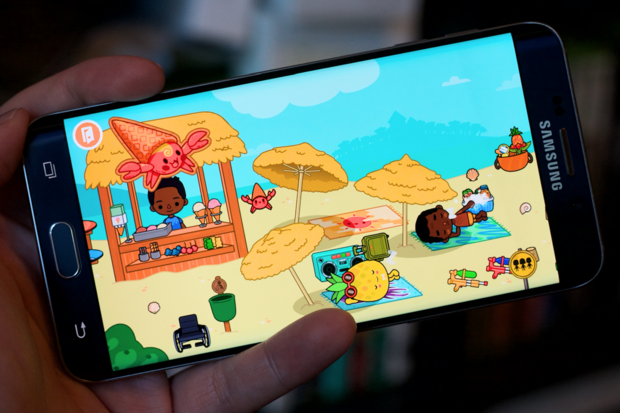
by Stone Marshall | Jun 21, 2016 | Minecraft News |
Looking for some new apps to help make your everyday phone use even more efficient? Or do you just want to have a bit of fun on your phone this weekend? We’ve got you covered on both fronts with our latest Five to Try column, which spotlights some new and updated Android options in the Play Store.
Evie is an interesting pick, as it shakes up the usual Android launcher approach by building the interface around an intelligent universal search bar, while Dango is designed to get you the contextual emoji and GIFs you need during conversations. Meanwhile, Minecraft: Pocket Edition got a huge update this week with dedicated servers and wider cross-platform play, while _PRISM is an alluring puzzler and Toca Life: Vacation is a perfect pick for the kids.
Evie’s home screen search bar taps not only into your local apps, but also info, maps, and services from the web.
Tired of hunting around your phone for the right app or service to complete a task? Evie could help: it’s a new home screen launcher built around a search bar. Start typing in a query, such as the name of an app, restaurant, movie, or nearby hotspot, and it’ll serve up options not only from your device but also the web, Yelp, and other services.
And from there, it’s even more useful. You can tap on a restaurant listing, for example, and have one-tap access to the correct app for placing a delivery order, as well as the ability to make a reservation or beckon an Uber or Lyft driver (with a cost estimate to boot). Search can often be siloed to just point you at apps or search within a single app, but Evie seems to bridge the gap and impresses as an all-in-one option for varying needs. If you spend far too much time digging through menus, it’s worth a look.
This week’s E3 gaming convention might have been mostly about big console and PC games, but even the years-old Minecraft took center stage for some big news of its own: Pocket Edition on Android now has cross-platform multiplayer that lets players link up over Xbox Live to play with iOS, Windows 10, and Gear VR players. And there’s another big feature in this week’s update—dubbed “The Friendly Update”—as the game now has support for dedicated servers.
Want to play online with one friend—or up to 10? Mojang’s Realms feature lets you pay a monthly fee for access to a server that continues on even when you’re not there, letting you create persistent worlds to share with friends. It’s $4/month for two total players or $8/month for up to 10 in the same space, although there’s a free month-long trial available for the larger plan.
Like Evie up top, Dango is an app designed to speed up everyday use of your phone… albeit in a very different way. See, Dango is an artificially intelligent app built to help pull up the emoji, animated GIFs, and stickers you need at any given moment. Once installed, it puts a little pink face in any chat or messaging above the keyboard; as you type, it reads the context of your message and suggests an ideal emoji to fit your note.
Tap the pink icon and you’ll see a wider range of suggestions, including several emoji, pop culture GIFs based on mood, and more. Better yet, Dango doesn’t just suggest images based on your in-progress messages, but also the ones sent your way, gaining context from conversation. If you’re a heavy GIF and emoji user, it could save precious seconds with every single missive.
Looks just like the pineapple-man I met on my last vacation…
Toca Boca is one of the premier developers for ad-free, kid-friendly apps, and its latest offering is perfectly primed for the summer school break. Released this week, Toca Life: Vacation ($3) drops you onto a tropical island resort, letting you choose from an array of characters and interact all around the locale, including at the hotel, beach, and even the airport.
Your cartoonish avatar can leap on the bed, x-ray a suitcase, fly an airplane, wander the boardwalk, and take on all sorts of other appropriately-themed activities. Toca Life: Vacation isn’t heavy on complex interactions, nor are there extensive games to play; rather, it’s a colorful and kid-centric way to have a little tropical fun wherever you are, and hopefully spur a little creativity in the process.
This might look totally confusing, but it makes sense once you start rotating the shape and touching the symbols.
Thanks to their multitouch screens, phones and tablets are ideal for the kind of puzzle games where you must push, pull, rotate, and otherwise manipulate objects. That’s why The Room trilogy has been so successful, and also why _PRISM ($3) might turn your head this week. It doesn’t have the spooky atmosphere or narrative threads of the former series, instead putting a mystical, serene spin on the act of solving these faux-physical brainteasers.
You’ll draw slide glyphs into place, rotate and shift icons, and hunt around each geometric shape to find the next input needed to expand the puzzle to its full size, with a mysterious and and colorful aesthetic throughout. _PRISM isn’t terribly long, promising about an hour’s worth of gameplay on average, but it’s well-designed, nicely presented, and should be a treat for fans of brainy-yet-tactile challenges.
Five to Try: Evie rethinks the Android launcher, and Minecraft gets friendlier than ever
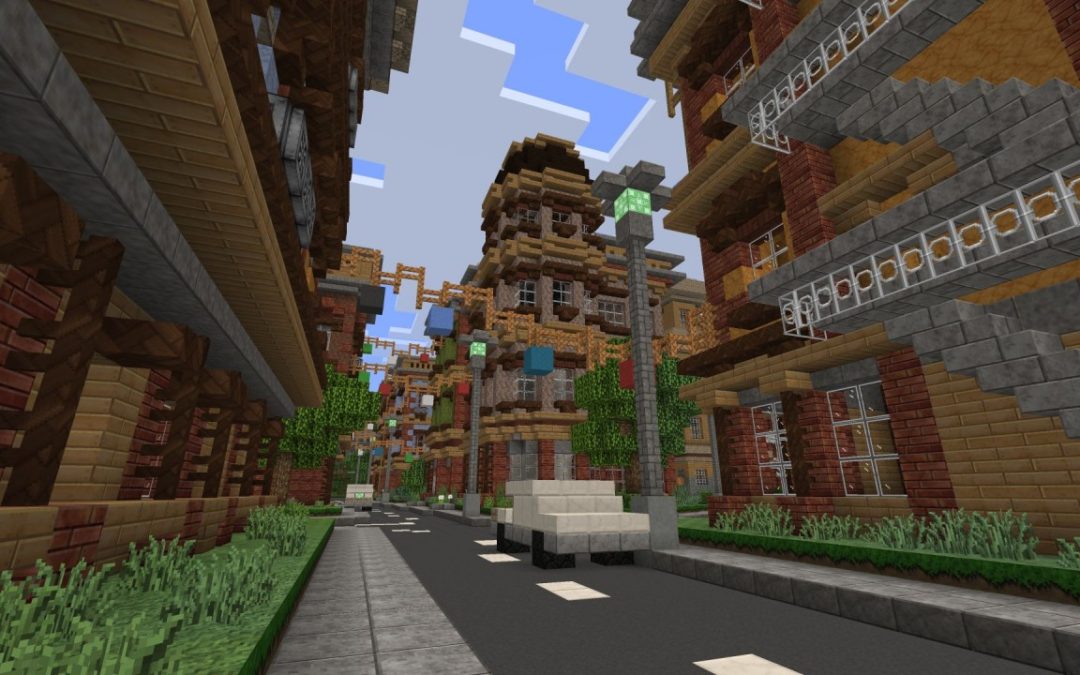
by Stone Marshall | Jun 21, 2016 | Minecraft News |
It’s been quite a while since Minecraft was a PC game. It’s on just about every platform you can imagine nowadays. One difference between the PC platform and every other platform out there, though, is the extraordinary modability of the former. While none of the countless mods created for Minecraft to this point have been officially supported, you can do all kinds of things to the game with user-created content.
Because none of those mods are supported, though, and because they’re made using reverse-engineered or extracted code, any update to the game can render the mods useless. Players end up playing years-old versions of the game just to keep their mods working, the devs say. I’ve done exactly that, so I know, at least anecdotally, that that’s accurate.
That’s exactly what the Minecraft team at Microsoft is looking to change with the new Add Ons initiative.
On top of working to let different platforms play together, as they’re already working on with the Windows 10 and mobile platforms, the team wants to let players make their games almost unrecognizable with custom worlds, tilesets, and monster behaviors. If you want to make chickens flammable and explosive, that’s definitely a thing you can do. You an make zombies behave like rabbits, right down to eating and mating. You could, as they showed, do a whole-world conversion and be playing in a city with aliens.
The plan is for these mods to eventually work on all platforms, including typically closed systems like consoles and iOS, explained senior producer James Webster in a hands-off preview at E3.
So how do you get in there and start modding?
What the team has done is make all the swappable parts of the game visible to the player in the form of text and image files. The text files, built in a format called JSON (Java Script Object Notation), look pretty intimidating at first, but looking for a few more seconds reveals that a lot of what’s in there is incredibly simple. A Creeper’s speed is set to 0.2. Crank that up to 1.0 to make creepers not just startling but downright terrifying. Save the the file and reload the mod pack and you’ll see creepers move with a new zest for life.
I expect that, in this age of YouTube tutorials, even the younger players will figure this system out in short order and start doing some absolutely wild stuff with this new access.
The idea behind making these add ons official is to make them secure and future-proof, meaning that you can’t break the game with these mods and they’ll work with all future versions of the game, so that you can upgrade when patches come out without fear.
The whole initiative seems very community-focused, and Webster and his team have a lot of faith in the community. They’re not worried about creating apps to assist with modding because they know their players will do that for them in short order. For example, I’m waiting for a mod that lets you paint textures directly onto the models, rather than using the somewhat confusing texture image files that look, as Webster described, a bit like taking the wrapping off a gift and laying it out flat.
Minecraft is one of the biggest communities out there, but the variety of platforms and the obsoletion of mods through upgrades have both done a lot to fragment the community. Letting platforms play and mod together will help to reunify that community and give one of the biggest games out there and even longer life.
Minecraft Add-Ons will change the game completely while unifying the game’s huge community
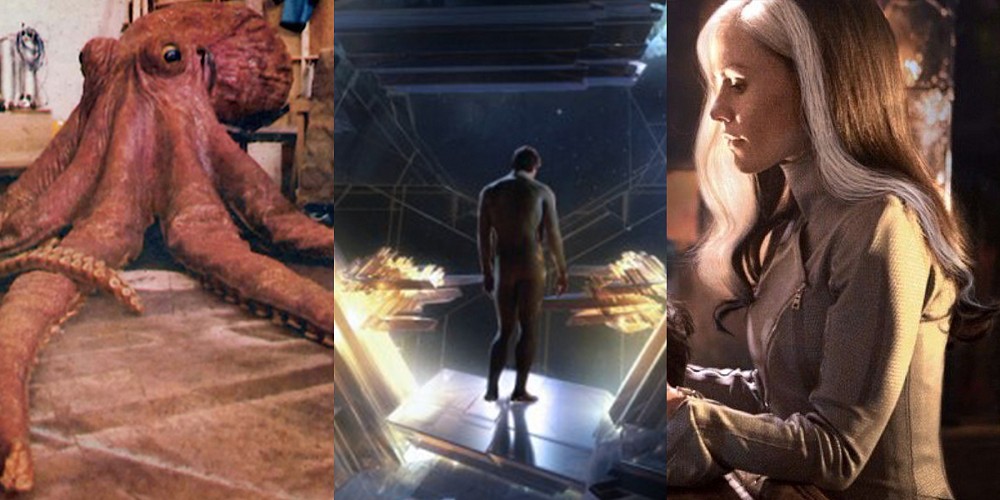
by Stone Marshall | Jun 20, 2016 | Awesome Book News |
Scenes in movies are deleted for a variety of reasons. Sometimes they don’t fit structurally, sometimes the movie’s runtime is already too long, but normally these cuts are small and don’t have an overwhelming effect on the plot. Occasionally, however, large, expensive chunks of a movie are gutted entirely and not only alter the movie, but wholly change the storyline.
The deleted scenes listed here fit into the latter category. Not only do the sections removed do away with entire plots, subplots, and actors, but they cost a boat-ton of money, resulting in millions and millions of dollars being virtually thrown away. Often, these lost treasures are relegated to the bonus-features section of a DVD, but on occasion they are lost to the ages with the creators unwilling to acknowledge their existence.
Here are The 11 Most Expensive Deleted Scenes Ever Filmed.
***All figures adjusted for inflation***
11. The Goonies – The Octopus Scene

For years people debated the existence of footage of an Ed Wood-esque monster attacking the children. When The Goonies was released on home video, it did not include this scene. However, when the television rights to the movie were eventually sold, distributors demanded that some of the more “adult” material be removed from the story, which resulted in a lack of footage. Their solution was to re-edit in the lost footage of the octopus attacking the kids back into the third act.
However, the octopus is still mentioned in the theatrical cut of the movie by Data, in the final scene, where he states “The Octopus was very scary.” Little information about the actual cost of the octopus footage exists, but with principle photography lasting 5 months, it is assumed that it took at least two days to capture the footage with the underwater unit, which would have cost the production $550,319.32 when adjusted for inflation.
10. The Wizard of Oz – The Jitterbug Dance
Deleted Scenes Wizard of Oz The 11 Most Expensive Deleted Scenes Ever Filmed
Immediately prior to the monkeys capturing Dorothy, there was supposed to be a scene featuring The Wicked Witch unleashing her “Jitterbug” upon them. This creature was to be a blue and pink mosquito-like creature that, after stinging them, made them break out into a six minute long song and dance number that took 5 weeks to rehearse and film. This was one of the first major pieces cut in the editing room due to the length of the picture.
Although the music to the song exists, and was subsequently released in 1995, no known footage exists other than a cheaply shot home movie by Harold Arlen, the composer of the movie. It has been reported that this scene set production back $1,013,678.57 when adjusted for inflation.
9. Dr. Strangelove – The Pie Fight
Deleted Scenes Dr. Strangelove The 11 Most Expensive Deleted Scenes Ever Filmed
The final scene in the movie was supposed to have the world leaders’ conversation break down, resulting in the greatest pie fight ever recorded on film. Although studio executives were not a fan of this, and insisted that Kubrick shoot it in one day, crew members place the actual filming time between one to two weeks. Each day, at least 2,000 Fortnum & Mason pies were brought to the stage, and were subsequently thrown, smashed, and made into sand castles. The footage was dropped after JFK’s assassination due to the dialogue, which included the line “…our President has been struck down by a pie in the prime of his life.”
Many sources incorrectly claim that this footage has been destroyed. Though it has never been screened for the public, Production Designer Ken Adams speaks about watching the footage at the BFI several years prior to his death. This scene took 1-2 weeks to film, so with principle photography taking 3 months, we estimate it set the production back $2,108,153.54 when adjusted for inflation.
8. Gangster Squad – Theater Shooting Scene
Deleted Scenes Gangster Squad The 11 Most Expensive Deleted Scenes Ever Filmed
On July 20th, 2012 a horrendous tragedy occurred in Aurora, Colorado when a man brought a gun into a screening of The Dark Knight Rises, killing 12 people and hurting 70 others. Prior to this, an almost finished version of Gangster Squad featured a crucial scene that took place in Grauman’s Chinese Theater, where gangsters attacked the audience with tommy guns. Ruben Fleischer and company agreed that this was no longer in good taste after the shootings in Aurora and pushed the film’s release back four months to make time for reshoots. Glimpses of the footage still exist on the internet in the form of the first released trailer.
This costly move set Warner Bros. back “several million” and forced a large section of the film to be completely retooled at the last second. With inflation, this set production back at least $2,060,313.32.
7. Back to the Future – Eric Stoltz Scenes
Deleted Scenes Back To The Future The 11 Most Expensive Deleted Scenes Ever Filmed
It’s not often that a main actor gets replaced once production on a movie has begun, let alone 5 weeks into it, but that was the case with Eric Stoltz as Marty McFly in Back to the Future. From the beginning, creators Robert Zemeckis and Bob Gale had insisted that Michael J. Fox should star in the role, but the head of the Universal, Sid Sheinberg disagreed to such a degree he proclaimed that if he was wrong, he would let them reshoot all his scenes… and that’s exactly what happened after Sheinberg watched the dailies.
Very small bits of this footage can be viewed in bonus content on recent Blu-ray releases. This reportedly cost the studio $4 million at the time, which is now worth $8,984,805.31 when adjusted for inflation.
6. Little Shop of Horrors – The Alternative Ending
Deleted Scenes Little Shop of Horrors The 11 Most Expensive Deleted Scenes Ever Filmed
When filmmakers screen their movies for test audiences, they fully expect that they may have to re-edit a scene here or there. Occasionally, they may even have to shoot a pickup shot to replace one that’s not well received. Unfortunately for director Frank Oz, two test audiences loved his movie, but despised the original ending, in which a plant not only ate the main character and his girlfriend, but took over the world.
In the end, a fifth of the budget, the work of 50-70 puppeteers, a year of visual effects work, five weeks of shooting, and 12 minutes of footage were relegated to the bonus features section of a Blu-ray that came out in 2012.
5. Superman Returns – Alternate Intro
Superman Intro Deleted Scenes The 11 Most Expensive Deleted Scenes Ever Filmed
Another case in which a film lost an entire bookend to the cutting room floor. In this film, however, the footage explains to the audience why Superman’s ship is crashing into Ma and Pa Kent’s farm, again, telling audience the same story they’ve heard many times before. Though the piece is gorgeous, it’s nearly 6 minutes in length and contains no dialogue, something studio execs generally frown upon.
Though the Blu-ray was released in 2006, this footage wouldn’t see the light of day until the Superman Anthology set was released in 2011, essentially turning this into a $12,018,546.74 bonus feature.
4. The Man Who Killed Don Quixote – The Entire Film
4 don The 11 Most Expensive Deleted Scenes Ever Filmed
In 2000, Terry Gilliam, Johnny Depp, Jean Rochefort, and an entire cast and crew traveled to an area just north of Madrid, Spain to film their latest project. The first of many problems was that this area was also the site of a major military base, making it nearly impossible to record sound. Soon afterward, there was a major flood that not only washed away much of their equipment, but wholly changed the color of the landscape. Lastly, after noticing Rochefort wincing each time he was on the horse, it was discovered that he was suffering from a double herniated disc.
It’s not all a loss though. The footage was later retooled and combined with narration from Jeff Bridges and making-of video in the excellent documentary Lost In La Mancha, chronicling the failure of the film. After a lawsuit, the investors were awarded $15 million from the company that insured the film. Gilliam has since claimed he is still making the project.
3. X-Men: Days of Future Past – Rogue’s Scenes
3 rogues The 11 Most Expensive Deleted Scenes Ever Filmed
Most of Anna Paquin’s scenes were removed from the theatrical cut of X-Men: Days of Future Past, but don’t feel too bad for her. Not only was she paid a reported $2.8 million for filming, her role was eventually reinserted into her own version of the movie appropriately titled, “The Rogue Cut.” With the standard version of the movie coming in at 2 hours and 12 minutes and the longer cut coming in at 2 hours and 29 minutes, one has to think that it wasn’t only a runtime issue.
In a movie that took place over two separate timelines with dozens of characters from two casts, the standard movie viewer already has a lot to absorb without the addition of yet another subplot.
This exorcism of footage not only cost the movie her $2.8 million , but also sent the film into 2 weeks of reshoots. When you factor in a reported $200 million dollar budget on an initial four month shoot schedule that brings the estimated cost of this deleted scene to $22,580,645.
2. World War Z – Entire Third Act
Deleted Scenes World War Z The 11 Most Expensive Deleted Scenes Ever Filmed
This movie’s original ending was dark. Like, dark dark. It contained Brad Pitt’s plane landing in Russia, where he was drafted into their anti-zombie army and his wife was forced into a relationship where she was trading sex in return for room and board for her and her daughters. It’s surprising that any executives actually greenlit such a dark ending for a summer blockbuster, but it’s not very surprising that they also decided to scrap it. Thus, Damon Lindelof and Drew Goddard were brought in to write an entire new ending.
According to reports, it cost a whopping $25 million to retool and reshoot the third act, making it the single most expensive piece of deleted material to never see a screen.
1. Cleopatra – 1/3rd of Entire Movie
Deleted Scenes Cleopatra The 11 Most Expensive Deleted Scenes Ever Filmed
After Cleopatra debuted, it became the biggest box office success in 1963. Despite that, it never made its enormous budget back. One of the most notoriously rocky movie shoots ever, Cleopatra was plagued by bad luck. The enormous sets were built in their entirety in London, and then again in Rome after production was forced to relocate. Elizabeth Taylor nearly died once on set before receiving a life-saving tracheotomy, of which the scar can be seen in some shots.
The original cut of the film was over 6 hours long, but Fox pressured director Joseph L. Mankiewicz to cut it down to its 3 hour theatrical cut. Eventually, a 4 hour cut was released on home video, and efforts are underway to reconstruct the 6 hour version so that we might see it one day.
The 11 Most Expensive Deleted Scenes Ever Filmed

